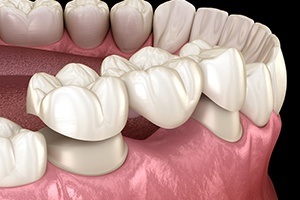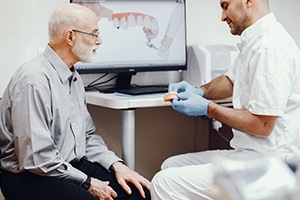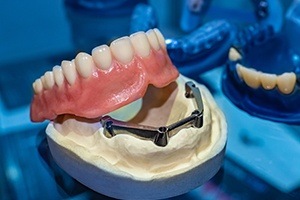Multiple Tooth Dental Implants – Bloomfield, CT
Seamlessly Rebuild
Lost Dentition

If you are missing several teeth, you have a number of tooth replacement treatment options in front of you. Most of the options replace only the visible portions of the lost teeth. Dental implants, on the other hand, rebuild the teeth from the roots up. On this page, you will learn more about both types of tooth replacement, including multiple tooth dental implants in Bloomfield, CT, so you can make a fully informed decision about how to rebuild your lost dentition and restore your mouth’s function and appearance.
Non-Implant Tooth Replacement Options

If you are not a candidate for dental implants, or you choose not to receive them, you may benefit from one of the following treatments:
- Crown and bridge. A dental bridge has two crowns, which get placed on the teeth on each end of the gap. The crowns support 1 – 3 artificial teeth between them that “bridge” the empty space. This type of restoration is a popular choice among patients who are missing just a few teeth in a row.
- Partial denture. A partial denture is a removable prosthetic that replaces multiple teeth at various places throughout a dental arch. It is sort of like a puzzle piece that fits in exactly where it is needed. Small metal clasps help to keep a partial denture in place.
- Full denture. A traditional full denture is a removable prosthetic that consists of a gum-colored base and a full arch of artificial teeth. Natural suction or a mild adhesive helps it to remain secure in the mouth through eating and speaking.
The Dental Implant Process

The process for replacing multiple teeth with dental implants takes place over the course of several months. It begins with a consultation, wherein we determine whether you are a good candidate for dental implants. Then, after any necessary preparatory work, you will undergo the implant placement surgery. Once the implants are in place, they will bond with the bone around them. This bonding process, called osseointegration, enables the implants to act as substitutes for the roots of the lost teeth. Following osseointegration, we design and place a custom bridge to go on top of the implants and thereby replace the visible portions of the lost teeth.
Benefits of Dental Implant-Retained Dental Prosthetics

We always recommend that patients who are candidates for dental implants opt to receive them rather than non-implant-supported tooth replacement. We do so because of the many benefits that dental implants offer:
- Because dental implants are self-supporting, they usually do not require that nearby teeth be modified or extracted.
- Dental implants support jawbone health.
- Since dental implants actually fuse to the bone around them, they are much more stable than prosthetics that simply sit on top of the gums.
- Implants may last for 30 years or longer, whereas a traditional denture may last for just 5 – 10 years or so.
Learn More

Are you ready to learn more about how the team at Family Dental Practice of Bloomfield can help you replace your lost teeth? Contact us today to ask questions or to schedule a consultation.
